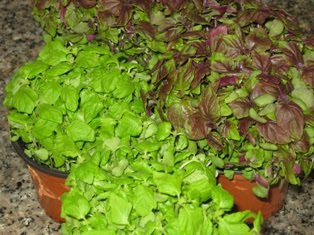Shiso a.k.a Perilla...
>> Thursday, 14 January 2010
Assalamualakum and Salam Sejahtera to all…
Vernacular Name: Shiso, Perilla, Purple Mint, Japanese basil, Wild Coleus, Sesame leaf, Beefsteak plant…
Botanic Name: Brassica Juncea
Family: Lamiaceae (Mint)
Organically grown, green and red/purple shiso...
Funny fact
I never knew Shiso was Perilla until one of ‘I am Herbed!” readers ask me to write about Perilla, then I googled it. The funny thing is, we have been using Shiso but only we never knew it was also known as Perilla. I went asking the Japanese Cuisine Chef (who is a Pilipino) about Perilla but he didn’t know it, in fact he ‘never heard of it’ he said, while Shiso was actually in the chiller (refrigerator).
Origin
The plant was believed to be originated in East and South Asia, although it is widely used in Japan , Korea , China and Vietnam
Content
The essential oil extracted from the leaves of perilla consists of a variety of chemical compound, depending on species. The most abundant, comprising about 50% to 60% of the oil is perillaldehyde which is most responsible for the aroma and taste of perilla.
Uses in food
Shiso that I used in the kitchen are mostly imported from neighboring country, Malaysia
Tips: when using perilla for soup/noodle soup, it is recommended to add them at the last phase of cooking, to let it boiled or steep just for a few minutes.
Picked shiso ready to be used...
Medicinal Uses
The Chinese traditionally used Shiso as medicine and has been shown to stimulate interferon activity (protein agent that prevents bacteria or viruses in our immune system). Shiso is also used as treatment for such ailments like indigestion, colds, malaria, cough and cholera. Other uses
I used shiso as pizza topping instead of basil...
I hope you enjoy reading...
Regards,
Chef Nash...






2 comments:
tia to is one of our favorite herbs and so important in Vietnamese cuisine
Hi, nice blog, very original. A warm hello from Oman.
Post a Comment